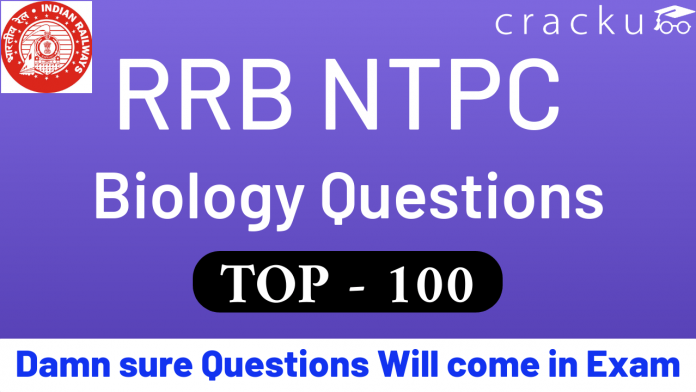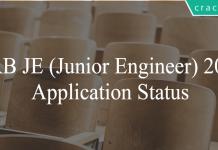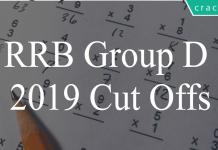Top-100 Expected RRB NTPC Biology Questions Set-1 PDF
Download Top-100 Expected Biology questions and answers for RRB NTPC Stage-1 exam. Go through the video of Repeatedly asked and most important RRB NTPC Biology questions. These questions are based on previous year questions in Railways and other Govt exams.
Download RRB NTPC Biology Question
Practice:
Take a free mock test for RRB NTPC
Practice 4500+ Solved Questions for RRB NTPC
Download:
Download RRB NTPC Previous Papers PDF
Download RRB NTPC Study Material PDF
Read this Post in Telugu
Question 1: Vitamin E is chiefly found in
a) Pulses
b) Butter
c) Germinated Grains
d) Oil of liver of fishes
Question 2: Which of the following are the only mammals that possess nucleated red blood corpuscles ?
(1) Camel
(2) Llama
(3) Man
(4) Dog
a) (1) and (2)
b) (2) and (3)
c) (3) and (4)
d) (1) and (4)
Question 3: Which of the following plays an important role in the cause of rainfall ?
a) Evaporation
b) Condensation
c) Both evaporation and condensation
d) Filtration
Question 4: When day-light hours are increased, the rate of photosynthesis :
a) increases
b) decreases
c) remains unchanged
d) None of the above
Question 5: The method of protecting iron from rusting by coating a thin layer of zinc is called
a) galvanizing
b) rancidity
c) alloy
d) pulverizing
Question 6: A person suffering from myopia cannot see the objects at :
a) near distance
b) longer distance
c) any distance
d) close to eye
Question 7: Quinine is obtained from which plant ?
a) Cinchona
b) Cocoa
c) Mulberry
d) Eucalyptus
Question 8: Which part of the tea plant is used for making tea ?
a) Root
b) Flower
c) Leaves
d) Stern
Question 9: Which process is used to harden the natural rubber?
a) Polymerization
b) Vulcanisation
c) Copolymerisation
d) Condensation
Question 10: Which of the following regulates the process of transpiration and gaseous exchange in plants?
a) Bracteate
b) Style
c) Stomata
d) Tendril
Question 11: Which of the following is also called as Leucocytes?
a) Red Blood Cells
b) Haemoglobin
c) Platelets
d) White Blood Cells
Question 12: The arrangement of flowers on the floral axis is termed as
a) Tendrils
b) Inflorescence
c) Spines
d) Calyx
Question 13: __________________ Respiration is a process in which organisms produce energy in absence of oxygen.
a) Aerobic
b) Anaerobic
c) Heterotrophic
d) Autotrophic
Question 14: The process of loosening and turning of the soil is called _________________.
a) winnowing
b) sowing
c) weeding
d) tilling
Question 15: How is the blood clot or ancestor (red brown sludge) formed by the fibers, usually within a given time, or in the cutting area?
a) Hiprops
b) Fibrins
c) Lymph (lymph)
d) Platelets
RRB NTPC Previous Papers [Download PDF]
RRB NTPC Study Material – 4500+ Questions
Question 16: Which of the following is a large number of cotton textile plants?
a) Telangana
b) Gujarat
c) West Bengal
d) Maharashtra
Question 17: How is the health component in the human development margin measured?
a) Expected Durability During Birth
b) Mother Death Rate
c) Illness
d) Child Mortality Rate
Question 18: How is the sequence of gaps in the odor in the peninsula?
a) Gametogenesis
b) Placentation
c) Theme (aestivation)
d) Oxygenation (Zygotogenesis)
Question 19: Which of the following removes colors from the solutions by grasping the color contamination?
a) Animal charcoal
b) Aluminum
c) Hydrogen
d) Potassium chlorate
Question 20: In angiosperms, the phenomenon of producing more than one embryo in their seed is called
_____________
a) Poly embryony
b) Diembryony
c) Monoembryony
d) Nucellar embryony
Question 21: What is the branch of biology under which the tissues are studied?
a) Pathology
b) Tissueology
c) Anatomy
d) Histology
Daily Free RRB Online Tests for RRB Exams
Question 22: The food chain in which the first level starts with plants as producers and ends with carnivores as consumers at the last level is called
a) Grazing Food Chain
b) Detritus Food Chain
c) The Decomposer Food Chain
d) The Producer Food Chain
Question 23: What does the Pineal gland secrete?
a) Insulin
b) Melatonin
c) Glucagon
d) Androgen
Question 24: ___________ transports food materials, usually from leaves to other parts of the plant.
a) Xylem
b) Vessel
c) Tracheids
d) Phloem
Question 25: Who discovered Ribosomes in cell biology?
a) Alec Jeffreys
b) D Ivanowsky
c) Stephen Hales
d) George Emil Palade
Question 26: The total number of bones in the average adult human skeleton is :
a) 350
b) 206
c) 115
d) 540
Question 27: Ammonia is prepared commercially by the :
a) Oswald process
b) Hall process
c) Contact process
d) Haber process
Question 28: Transpiration in leaves occurs mainly through ____________
a) Stomata
b) Apoplast
c) Microfibrils
d) Plasmodesmata
Question 29: The visible surface of the Sun is called
a) Atmosphere
b) Lithosphere
c) Photosphere
d) Ionosphere
Question 30: Malfunctioning of kidneys can lead to accumulation of urea in blood, a condition called____________
a) Renal calculi
b) Glomerulonephritis
c) Renal failure
d) Uremia
Question 31: Secretion of insulin Hormone is by :
a) Thyroid
b) Pituitary
c) Adrenal
d) Pancreas
Question 32: Red rot is a plant disease which affects :
a) Wheat
b) Rice
c) Sugarcane
d) Cotton
Question 33: Earthworm belongs to which of the following Animal Phyla ?
Top-100 Expected RRB NTPC Biology Questions Set-1 PDFa) Arthropoda
b) Mollu sca
c) Annelida
d) Protozoa
RRB NTPC Previous Papers [Download PDF]
Question 34: Aquarium is a container in which there are living fish and aquatic plants. Which statement about aquarium is correct?
a) It is human made ecosystem
b) It is a natural ecosystem
c) It is not an ecosystem at all
d) It can only be termed a community
Question 35: HIV is passed from one person to another in all of the following ways except:
a) Mosquito bite
b) Breast Feeding
c) Sharing Needles
d) Sexual Contact
Question 36: Which of the following hormone is not secreted by Pituitary gland?
a) Thyroid-stimulating hormone (TSH).
b) Prolactin
c) Vasopressin
d) Somatostatin
Question 37: ……… is not related to gases.
a) Boyle’s Law
b) Joule’s Law
c) Avogadro’s Law
d) Charles’s Law
Question 38: …….. is known as a disease mostly caused by occupational health hazards.
a) Syphilis
b) Cirrhosis
c) Silicosis
d) Parkinson’s
Question 39: The medicine paracetamol is
a) An analgesic
b) An antipyretic
c) An analgesic and antipyretic
d) A nonsteroidal anti-inflammatory drug
Question 40: A person with blood group AB
a) Can donate blood to persons with blood group A, B and O.
b) Is called universal blood donor.
c) Can receive blood from any group.
d) Is neither a universal recipient nor a donor.
Question 41: Prostate in human body is a
a) Connective tissue
b) Gland
c) Membrane
d) Muscle
RRB NTPC Previous Papers [Download PDF]
RRB NTPC Study Material (Download PDF)
Question 42: Arteries carry blood, that is filled with
a) Oxygen
b) Carbon dioxide
c) Toxins
d) Lipids
Question 43: Which of the following is reared for its fleece/fiber?
a) Alpaca
b) Alabama
c) Apache
d) Alluvial
Question 44: Transpiration takes place through the ……………
a) vascular bundles
b) cortex
c) stomata
d) epidermis
Question 45: In which of the following phenomena can many plants be grown from one parent in disease-free conditions?
a) Sexual reproduction
b) Tissue culture
c) Spore formation
d) Regeneration
Question 46: The ………. system transports fluids from one place to another.
a) respiratory
b) vascular
c) nervous
d) excretory
Question 47: Which of the following tissues is composed of mainly dead cells?
a) Parenchyma
b) Collenchyma
c) Aerenchyma
d) Xylem
Question 48: Amoeba, Paramecium and Bacteria undergo:
a) sexual reproduction
b) budding
c) binary fission
d) multiple fission
Question 49: The secretion from the prostate gland enters into the:
a) Kidney
b) Ureter
c) Urethra
d) Testis
Question 50: What type of tissue are our bones?
a) parenchyma
b) Permanent tissue
c) Epidermic
d) Connective
Question 51: ……… reproduces by binary fission
a) Amoeba
b) Liverfiuke
c) Plasmodium
d) Planaria
Question 52: Which type of cell, skin is made up of:
a) Epidermal cells
b) Connective tissue
c) Permanent tissues
d) Parenchyma
Question 53: ……….. connects muscle to the bones.
a) Cartilage
b) Areolar
c) Ligaments
d) Tendons
Question 54: ……………. connects bones.
a) Ligament
b) Areolar
c) Tendon
d) Cartilage
Download General Science Notes PDF
Question 55: During which of the following types of reproduction do the fully matured tiny individuals detach from the parent body and become new independent individuals?
a) Fission
b) Regeneration
c) Budding
d) Multiple fission
Question 56: Hydra, starfish, planaria undergo:
a) sporulation
b) regeneration
c) Budding
d) fragmentation
Question 57: Which tissue is responsible for transport of materials away from the root?
a) Ground tissue
b) Cambium
c) Phloem
d) Xylem
Question 58: Transfer of pollengrains from anther to the stigma of a flower is called …………
a) Pollination
b) Regeneration
c) Transpiration
d) Sexual reproduction
Question 59: Genetic information is carried by long chains of molecules. What are these molecules called?
a) Phosphates
b) Nitrogenous Bases
c) RNA
d) Nucleotides
Question 60: …….. tissue is found beneath the skin, around the kidneys and between the internal organs.
a) Ligament
b) Areolar
c) Tendons
d) Adipose
Question 61: In …….. tissue the cells are widely spaced.
a) Tendons
b) Cartilage
c) Bone
d) Ligament
Question 62: ………… describes pollination by the agency of ants.
a) Emasculation
b) Ficus Religiosa
c) Dirmecophily
d) Myrmecophily
Question 63: The process of releasing of an egg from the ovary is called ……….
a) Fertilisation
b) Reproduction
c) Gestation
d) Ovulation
Question 64: Fibers are absent in:
a) Liver
b) Blood
c) Kidney
d) Heart
Question 65: The reproductive parts of angiosperms are located in the:
a) leaves
b) flowers
c) roots
d) stems
Question 66: The organs that have different basic structure (or different basic design) but have similar appearance and perform 5 similar functions are called:
a) biogenetic law
b) analogous organs
c) homologous organs
d) fossils
Question 67: Which of the following is not a Connective Tissue?
a) Cartilage tissue
b) Muscular Tissue
c) Adipose Tissue
d) Ligament
Question 68: Fats and oils become rancid because of:
a) transpiration
b) reduction
c) oxidation
d) corrosion
Question 69: Which of the following produces Testosterone in man?
a) Prostate gland
b) Scrotum
c) Testes
d) Vas deferens
Question 70: The carpel contains …………
a) Pollen grains
b) Sepals
c) Petals
d) Ovules
Question 71: Xylem is a/an ……… tissue.
a) simple permanent
b) complex permanent
c) epithelial
d) connective
Question 72: The plant hormone that helps in the growth of the stem is ………..
a) Gibberellins
b) Cytokinins
c) Auxins
d) Insulin
Question 73: The plant parts tends to move towards light, this phenomenon is called :
a) Positive phototropism
b) Negative tropism
c) Positive tropism
d) Negative phototropism
Question 74: Rise in sugar levels in blood is detected by the cells of:
a) Liver
b) Gall bladder
c) Kidney
d) Pancreas
Question 75: Which of the following is a work done by the placenta tissue in humans?
a) Support the embryo
b) Removes waste matter from the embryo and provide nutrition to the embryo
c) Provide nutrition to the embryo
d) Remove waste matter from the embryo
Daily Free RRB Online Tests for RRB Exams
Question 76: Which tissue makes the plant hard and stiff?
a) Parenchyma
b) Sclerenchyma
c) Collenchyma
d) Xylem
Question 77: Fishes have a …….. chambered heart.
a) Single
b) Three
c) Four
d) Two
Question 78: Acidity in a person can be cured by consuming …………..
a) baking soda solution
b) vinegar solution
c) lemon juice
d) butter milk
Question 79: Due to the presence of ………, a type of connective tissue in our ears, the ears can be folded.
a) Bones
b) Cartilages
c) Tendons
d) Ligaments
Question 80: ……….. are analogous organs.
a) the tailfin of a lobster and the flukes of a whale
b) A human arm and a bulls leg
c) A bat’s wing and a whale’s fin
d) The leg of a dog and the flipper of a dolphin
Question 81: Herbivores require a longer small intestine to digest ………….
a) Proteins
b) Fats
c) Cellulose
d) Vitamins
Question 82: An individual nerve cell may be up to ……….. long.
a) 100 cm
b) 50 cm
c) 80 cm
d) 10 cm
Question 83: Litmus solution is extracted from:
a) Hydrangea
b) Geranium
c) Petunia
d) Lichen
Question 84: How does Amoeba reproduce?
a) Sexual Reproduction
b) Budding
c) Binary fission
d) Fragmentation
Question 85: Most reptiles have:
a) Incompletely three chambered heart
b) three chambered heart
c) four chambered heart
d) Two chambered heart
RRB NTPC Previous Papers [Download PDF]
Question 86: The ……… consists of relatively unspecialised cells with thin cell wall. (a-delete)
a) phloem
b) sclerenchyma
c) parenchyma
d) collenchyma
Question 87: ………… is not a sexually transmitted disease.
a) Candidiasis
b) Syphilis
c) Gonorrhea
d) Warts
Question 88: In animal cells, ……… epithelium forms the inner lining of the kidney to provide mechanical support.
a) Glandular
b) Cuboidal
c) Columnar
d) Squamous
Question 89: What is Sublimation?
a) It is the process of conversion of a liquid into gas.
b) It is the process of conversion of a solid into liquid.
c) It is the process of conversion of a solid into vapour.
d) It is the process of conversion of a gas into liquid.
Question 90: Which of the following is an example of a Rhizome?
a) Ginger
b) Sugarcane
c) Onion
d) Potato
Question 91: Plants in the ………… group are commonly called algae.
a) Bryophyta
b) Thallophyta
c) Gymnosperms
d) Pteridophyta
Question 92: What is the junction between an axon ending with the dendrite of another nerve cell called?
a) Synapse
b) Neuron
c) Synaptic Cleft
d) Node of Ranvier
Question 93: A/An ………….. tissue is formed beneath the skin and between internal organs.
a) Epithelial
b) Nervous
c) Muscular
d) Adipose
Question 94: Asexual reproduction takes place in:
a) Plants
b) Higher animals
c) Lower animals
d) Lower animals and plants
Question 95: ……… mutation is NOT hereditary.
a) Deletion
b) Insertion
c) Somatic
d) Duplication
Question 96: Voluntary muscles are contained in the ………
a) heart
b) hind limb
c) liver
d) lung
Question 97: In …………. cells are loosely packed so that large intercellular spaces are found.
a) Parenchyma
b) Tracheids
c) Sclerenchyma
d) Collenchyma
Question 98: ……….. is not the same as reproduction.
a) Budding
b) Fission
c) Multiple fission
d) Regeneration
Question 99: ……. Theory of Evolution tells us how life evolved from simple to more complex forms.
a) Darwins
b) Wallace
c) Mendel’s
d) Lamarck’s
Question 100: Plants that have lost their capacity to produce seeds reproduce by the method of:
a) Fission
b) Vegetative propagation
c) Multiple fission
d) Budding
RRB NTPC Free Study Material – 4500 Questions
Answers & Solutions:
1) Answer (B)
2) Answer (D)
A Very Low number ( Nucleated Red Blood Cells) are seen in Dogs.
3) Answer (C)
4) Answer (A)
5) Answer (A)
6) Answer (B)
7) Answer (A)
8) Answer (C)
9) Answer (B)
10) Answer (C)
11) Answer (D)
12) Answer (B)
13) Answer (B)
14) Answer (D)
15) Answer (B)
16) Answer (D)
17) Answer (A)
18) Answer (B)
19) Answer (A)
20) Answer (A)
21) Answer (D)
22) Answer (A)
23) Answer (B)
24) Answer (D)
25) Answer (D)
26) Answer (B)
27) Answer (D)
28) Answer (A)
29) Answer (C)
30) Answer (D)
31) Answer (D)
32) Answer (C)
33) Answer (C)
34) Answer (A)
35) Answer (A)
36) Answer (D)
37) Answer (B)
38) Answer (C)
39) Answer (C)
40) Answer (C)
41) Answer (B)
42) Answer (A)
43) Answer (A)
44) Answer (C)
45) Answer (B)
46) Answer (B)
47) Answer (D)
48) Answer (C)
49) Answer (C)
50) Answer (D)
51) Answer (A)
52) Answer (A)
53) Answer (D)
54) Answer (A)
55) Answer (C)
56) Answer (B)
57) Answer (D)
58) Answer (A)
59) Answer (D)
60) Answer (D)
61) Answer (B)
62) Answer (D)
63) Answer (D)
64) Answer (B)
65) Answer (B)
66) Answer (B)
67) Answer (B)
68) Answer (C)
69) Answer (C)
70) Answer (D)
71) Answer (B)
72) Answer (C)
73) Answer (A)
74) Answer (D)
75) Answer (B)
76) Answer (B)
77) Answer (D)
78) Answer (A)
79) Answer (B)
80) Answer (A)
81) Answer (C)
82) Answer (A)
83) Answer (D)
84) Answer (C)
85) Answer (B)
86) Answer (C)
87) Answer (A)
88) Answer (B)
89) Answer (C)
90) Answer (A)
91) Answer (B)
92) Answer (A)
93) Answer (D)
94) Answer (D)
95) Answer (C)
96) Answer (B)
97) Answer (A)
98) Answer (D)
99) Answer (A)
100) Answer (B)
DOWNLOAD APP FOR RRB FREE MOCKS
We hope this very important RRB NTPC Chemistry Questions will be very helpful to you.





